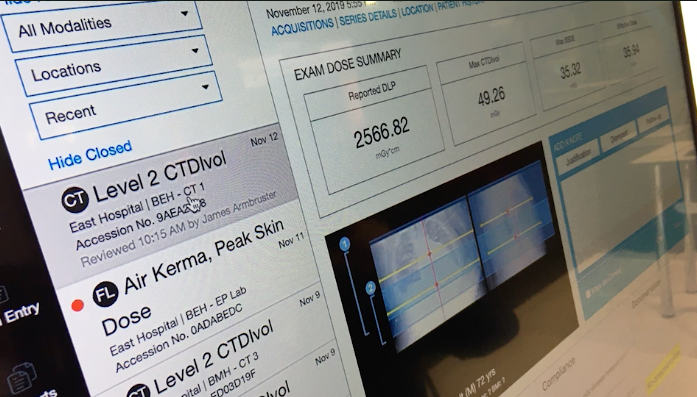
Dose tracking software allows hospitals and imaging centers to track levels of radiation used by exam type protocol. It can flag technologists who are using higher than required doses who may benefit from additional ALARA training. The radiation dose tracking systems also can help track the amount of radiation a patient has received over time.
Cynthia McCollough, Ph.D., director of Mayo Clinic’s Computed Tomography (CT) Clinical Innovation Center, spoke with Imaging Technology News (ITN) at the Radiological Society of North America’s (RSNA) 2021 annual meeting on how CT dose tracking software works, and offered advice to centers that record this patient level and device information.
Imaging Exam Guidelines
There have been great strides with new detector technologies and iterative reconstruction to try to lower radiation dose. In addition to dose reduction, dose tracking is also a topic that has been discussed for many years.
McCollough said that there are a number of manufacturers that will tag onto a PACS system or get output directly from the devices to record the delivered scanner dose, then run calculations to try to apply that dose to a human model. “Not all of them are validated in the literature,” she stated. “So, it’s good for quality assurance, if you see outliers, to dig in and find out what’s going on that wasn’t understood.”
It is the position of the American Association of Physicists in Medicine (AAPM), the American College of Radiology (ACR), and the Health Physics Society (HPS) that the decision to perform a medical imaging exam should be based on clinical grounds, including the information available from prior imaging results, and not on the dose from prior imaging-related radiation exposures. In August 2021, the collective groups put out a statement cautioning people about sharing that information without guidelines, because it’s not standardized.
Image Wisely has endorsed the joint statement, which clarifies the evidence-based position and consensus of the organizations that medical imaging exams should be ordered for clinical reasons, and that exam ordering should not be based on past radiation exposures.
“This joint statement is a powerful confirmation of the medical radiological community’s commitment to providing the right exam, for the right patient, at the right time,” said Diana Litmanovich, M.D., FNASCI, and Image Wisely co-chair, in a written statement. Beth Schueler, Ph.D., FAAPM, FACR, and Image Wisely co-chair, added, “The community invests so much in providing tools for appropriate exam ordering. Tracking dose indices is an important component of quality assurance and process optimization in radiology, but incorporating past radiation exposures into medical imaging exam ordering is inappropriate.”
This statement has also been endorsed by the American Society for Radiation Oncology (ASTRO), The Association for Medical Imaging Management (AHRA), the Radiological Society of North America (RSNA), the Society for Cardiovascular Computed Tomography (SCCT) and the Society of Nuclear Medicine and Molecular Imaging (SNMMI).
Quality Assurance
Dose tracking remains an important aspect of quality patient care. “I think that without data, you can’t do good quality assurance,” stressed McCollough. “You don’t know if for some reason you have one particular technologist who had a misunderstanding or miscommunication, and that one person, every time they scan and deliver the dose, it’s twice as high as everyone else in the practice. If you don’t have numbers, you can’t find those things and improve quality. But on an absolute scale in terms of medical decision making, I think that the dose numbers should take a very low priority. It is all about justification.”
She went on to state that the International Commission on Radiological Protection (ICRP) has always taken the premise that you don’t put a dose limit on in medical situations. “Just like if a patient comes in the emergency department and is in pain, you give them morphine if they need it, even though they may have risks for addiction. As long as medicine, and physicians, have the final say, then checking doses is okay. But it shouldn’t decide or make decisions for physicians.”
View the Radiation Dose Management Comparison Chart
Related Radiation Dose Tracking Systems:
VIDEO: Radiation Dose Tracking Software for CT Imaging
Disputed EHR Dose Levels Could Keep Patients From Necessary Imaging Exams
Medical Imaging Radiation Exposure in U.S. Dropped Over Past Decade
VIDEO: Radiation From Medical Imaging in U.S. Dropped Over Past Decade
The Basics of Radiation Dose Monitoring in Medical Imaging
VIDEO: Radiation Dose Monitoring in Medical Imaging — Interview with Mahadevappa Mahesh, Ph.D.


 December 09, 2025
December 09, 2025 









